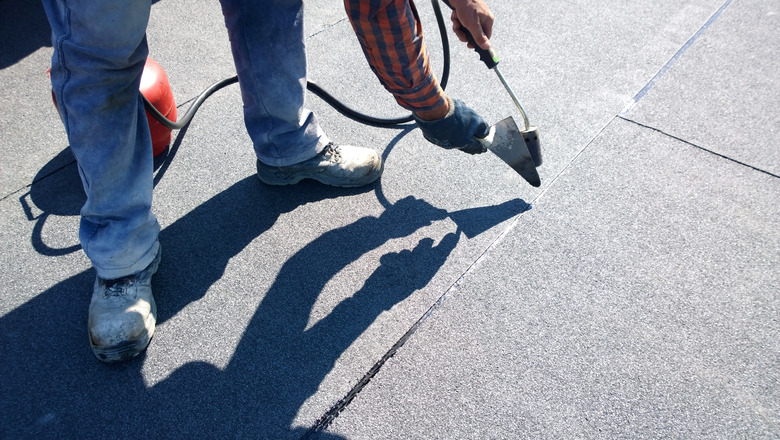How Thick Is Roofing Felt?
Roofing felt, also referred to as "builder's felt" or "roofing felt paper," is underlayed on roofs before coverings like asphalt or wood shingles are added. Resembling black tar paper, roofing felt's main purpose is to prevent moisture from leaking into a roof. Available in rolls, roofing felt is made with a fiberglass or polyester center and saturated with pieces of asphalt, tar and bituminous coal. It is sometimes coated with sand.
The different types of roofing felt paper are different weights which results in different thicknesses. The #30 is twice as heavy as #15 and it is substantially thicker, although no exact thickness figures are provided. In the past, the felt number designation related to the felt paper weight, so that a# 15 felt weighed 15 pounds per 100 square feet, while a #30 felt paper weighed 30 pounds. However, that direct correlation to weight no longer exists. Today #15 felt can weigh 7.5 to 12.5 pounds per square while #30 felt can weigh between 16 and 27 pounds per square.
Roofing Paper Thickness
Roofing Paper Thickness
Roofing felt's thickness is not a measurement of its depth because it is thin, similar to heavy paper. Roofing felt's thickness is actually measured in pounds per square, with one square equaling 100 feet of roofing material. The most commonly used felts are #15 and #30, with weights of 8 and 20 pounds per 100 square feet, respectively.
The most commonly used is #15, which comes in rolls 3 feet wide, is 144-feet long and covers approximately four squares per roll, or approximately 400 feet of roof. Felt #30 also comes in rolls 3 feet wide and covers approximately two roof squares per roll, or approximately 200 feet. The rolls can be cut to various lengths, as needed.
Building Codes on Roofing Paper
Building Codes on Roofing Paper
Building codes in some municipalities require installation of #15 or heavier felt. In addition, roofing felt is generally required for insurance purposes for the Underwriter's Laboratory fire rating to apply to roofing. Besides preventing leaks and retarding fire, roofing felt also prevents lumber resin in roof decks from damaging shingles. It also makes a roof look smooth, as it prevents the underneath roof sheathing from showing through the shingles.
Roofing Felt for Asphalt Shingles
Roofing Felt for Asphalt Shingles
Asphalt shingles are the most commonly used covering for homes in the United States. Four out of five homes are covered with asphalt shingles, according to the Asphalt Roofing Manufacturers Association. The type and amount of roofing felt to apply varies according to roof slope. If the slope is between 3:12 and 4:12, use two layers of #15 felt for asphalt shingles. If the slope is greater than 4:12 — which provides more water drainage from the roof — use one layer of #15 felt. Use #15 for asphalt shingles weighing 240 pounds per square or less; consider using #30 only if shingle weight is heavier than 240 pounds.
Roofing Felt Tips
Roofing Felt Tips
Manufacturers of roofing products sometimes have specifications for the material underlaying them, which should be carefully followed. When applying roofing felt, pay careful attention to areas that receive the most water runoff, including roof hips, ridges and areas around adjoining walls. Cover those areas with an additional 6 inches of felt, from each direction.
